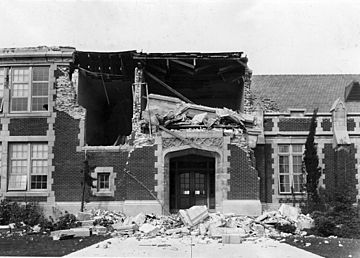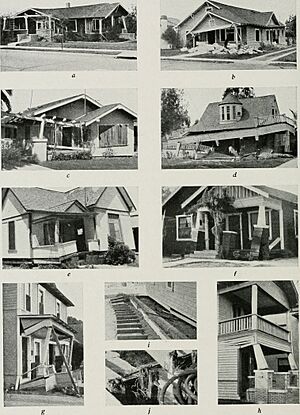1933 Long Beach earthquake facts for kids

Damage to the John Muir School, Pacific Avenue, Long Beach
|
|
| UTC time | 1933-03-11 01:54:00 |
|---|---|
| ISC event | 905457 |
| USGS-ANSS | ComCat |
| Local date | March 10, 1933 |
| Local time | 5:54 P.M. PST |
| Magnitude | 6.4 Mw |
| Depth | 10 km (6.2 mi) |
| Epicenter | 33°37′52″N 118°00′00″W / 33.631°N 118.000°W |
| Fault | Newport-Inglewood Fault |
| Type | Strike-slip |
| Areas affected | South Coast (California) United States |
| Total damage | $40 million |
| Max. intensity | VIII (Severe) |
| Peak acceleration | 0.22 g |
| Peak velocity | 20 cm/s (est) |
| Tsunami | No |
| Aftershocks | M5.4 on Oct 2 1933 |
| Casualties | 115–120 killed |
The 1933 Long Beach earthquake happened on March 10 at 5:54 P.M. PST. Its center was off the coast, near Long Beach, California. This earthquake was quite strong, with a magnitude of 6.4. It caused a lot of damage to buildings across Southern California. Sadly, 115 to 120 people died. The damage cost about $40 million, which is a lot of money even today. Most people who died were hit by falling debris as they ran out of buildings.
Contents
How the Earthquake Caused Damage
Major damage hit the city of Long Beach, which had many people living there. Industrial areas south of downtown Los Angeles were also affected. The earthquake was felt over a huge area, reaching places like the San Joaquin Valley and even Northern Baja California.
Even though the earthquake was not the strongest ever, it caused a lot of damage. This was because of the ground conditions, like soft soil and alluvium (silt, sand, and gravel). Many buildings were also not built very well. In Long Beach, buildings fell down, water tanks crashed through roofs, and houses were knocked off their foundations.
School buildings were hit especially hard. In just a few seconds, 120 schools in the Long Beach area were damaged. About 70 of these schools were completely destroyed. Experts realized that school buildings suffered so much because they were made with unreinforced masonry walls. These walls did not have steel bars inside to make them stronger.
A newspaper article from 2008 said that the 1933 earthquake changed how buildings were constructed. It led to much better school building rules and made people more aware of earthquake dangers. The La Grande Station, a big train station in Los Angeles, was also badly damaged.
What Happened After the Earthquake?
The earthquake showed that buildings in California needed to be designed to survive earthquakes. More than 230 school buildings were destroyed or badly damaged. Many schools had to close for a long time because they were unsafe. Students had to go to classes held in tents. A lot of money was needed to fix these damaged school buildings.
The damage to the La Grande Station led to the building of Los Angeles Union Station. This new station was built where Chinatown, Los Angeles used to be.
This earthquake also made the government get involved in helping after disasters. The government created the Reconstruction Finance Corporation. This group gave loans to help rebuild damaged buildings. If the earthquake had happened during school hours, many more children might have died. Because of this, California passed the Field Act. This law made sure that building designs followed strict safety rules. It also required experts to check building plans and inspect construction.
The Bureau of Public Roads also helped rebuild roads, highways, and bridges. Long Beach's economy quickly got back to normal. This was thanks to the growing aircraft industry. To help with World War II, Long Beach built naval yards and made more airplanes. This helped the city recover and become strong again after the disaster.
Why Did the Earthquake Happen?
The 1933 Long Beach earthquake might have been caused by human activity. Research from the United States Geological Survey (USGS) in 2016 suggested it was caused by oil and gas extraction under the city.
Other studies show that many earthquakes during Los Angeles's oil boom years were likely caused by oil drilling. Back then, companies removed millions of barrels of oil but did not replace it with other liquids. This put stress on the faults in the ground. A USGS study suggests that drilling in the Huntington Beach area caused the 1933 earthquake. Other studies also point to oil drilling causing earthquakes in nearby areas in the 1920s. Scientists found that these earthquakes happened near places where oil production changed a lot.
Man-made earthquakes are still a problem today, especially in places like Oklahoma and Texas. Recent studies show that injecting wastewater into the ground can cause more earthquakes.
The Newport-Inglewood Fault was the source of the 1933 earthquake. This fault moves sideways, and it runs parallel to other major faults in California. It stretches about 46 miles on land, from Culver City to Newport Beach, then goes into the Pacific Ocean. Experts believe this fault could cause an earthquake as strong as magnitude 7.4. The 1933 earthquake was a magnitude 6.4. This means a 7.4 earthquake would cause about ten times more shaking and release 1,000 times more energy.
The Earthquake in Movies and Books
The 1933 film Headline Shooter used real news footage of the Long Beach earthquake. A 1933 documentary called Quake! Its Effect on Long Beach and Compton California also showed footage from that time.
The earthquake is an important part of the novel The Last Tycoon (1941) by F. Scott Fitzgerald. In the story, the main character, Monroe Stahr, meets Kathleen Moore during the earthquake's chaos. They then fall in love.
The earthquake is also mentioned in John Fante's book Ask the Dust (1939).
A radio news report about the earthquake's aftermath is heard in an episode of The Waltons.
An actor named Ian Wolfe mentioned this earthquake in an episode of Police Woman. He also talked about the 1971 San Fernando earthquake.
Footage of the earthquake was also shown in the film Encounter with Disaster, released in 1979.





